
Huh Sangwook, Buncheong Vase with Design in Underglaze Cobalt-blue and Silver Paint, 2020. Commissioned by Dochwi for the exhibition Imaginary Animals, Auspicious Companions (2020). ©Dochwidochwi
Moon Yujin finds a consolation of animality in contemporary South Korean ceramics, especially in the playful work of Yon Hokyung
I picture beings that can accompany us at our side, making eye contact, helping put a smile on our faces and transferring positive energy—mystical animals that seemed to have been seen somewhere, existences that defend the order of nature and values that humans fail to maintain, animals that spark conversations with us, telling us that good things will happen and wishing us health and well-being, animals that tell us stories intertwined with the history of mankind, at times with dignity, and at other times with humor.
In this light, Imaginary Animals, Auspicious Companions was born with the notion of consolation. It is the mission of Dochwi (12-27, Keep in Touch, Seoul) to introduce to the public through organized curation the ceramic works of our time, many of which lay hidden like treasures, and to expand the opportunities to enjoy them, thereby deepening appreciation for them. In conjunction with this mission, Imaginary Animals, Auspicious Companions has been organized with the aim of offering everyone the opportunity to approach ceramics in a simple and comfortable manner.
Depictions of animals and pictorial representations executed on earthen surfaces have played a role in providing emotional comfort to humans, practically and symbolically, since the days when we lived in caves. From infancy, children today encounter images of animals in picture books, draw animals faces in the sand at the playground, and make sculptures of animals out of clay at school. When they become adults, they express their emotions using faces of imaginary characters in the form of emojis. However, the spiritual animals that were born thousands of years ago remain asleep in antique art, having lost almost all of their meaning in the present day. Imaginary Animals, Auspicious Companions seeks to bring these animals back to life through the efforts of contemporary artists, that is, awaken them out of the ground and to bring them back into our daily lives.
Consoling Companions
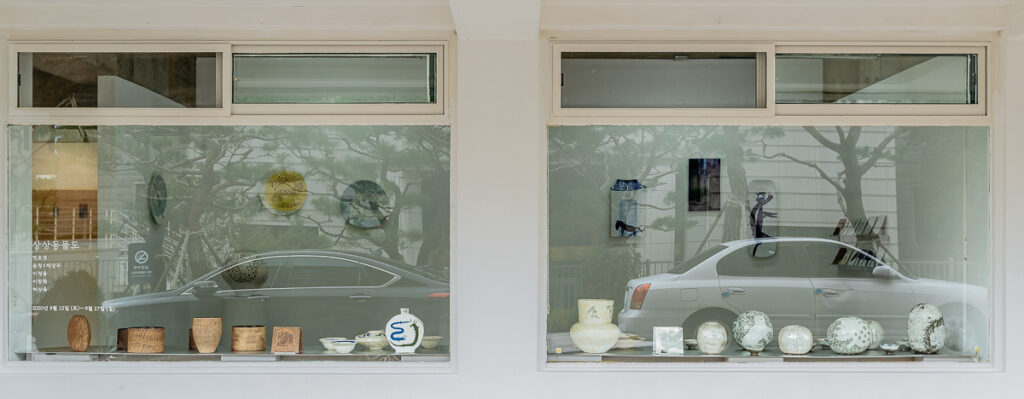
Imaginary Animals, Auspicious Companions (12 – 27 Sept. 2020, Keep in Touch Seoul) Exhibition view. ©Dochwidochwi
The history of drawing on natural earthen surfaces goes hand-in-hand with the history of art. From prehistoric times, humans have painted images of animals using mineral pigments or carved them on rock walls, and the dirt walls of ancient tombs and houses have been adorned with representations of people, (urban or imaginary) landscapes, and animals. Earthenware was decorated with geometric patterns, mythical figures, and symbolic designs, and narrative scenes and icons demonstrating the power of cities and nations or religious teachings were carved into rocks and bricks or presented in mosaics. With the discovery of new materials, the development of methods for expression, and the evolution of aesthetics, drawings executed on earthen surfaces and drawings as a form of visual art separated and came to develop their own respective languages. However, the former still continues to exude vitality in the form of ceramics, the oldest composite product of nature and human knowledge.
Of the numerous existences and concepts that humans have expressed in natural earthen surfaces, animals are the most common subjects regardless of the period or region. From hunting targets to livestock providing labor and food, working animals supporting human life, and pets sharing emotional companionship with humans, animals, as evidenced by the varied roles they play in the lives of people, have long been the most important and therefore the closest beings in human life. It is no coincidence that the history of art begins with animal paintings. Today, it is a video of a cat next door yawning peacefully, a dog that understands the words of his owner, a koala eating eucalyptus leaves with sleepy eyes on the other side of the globe, or a waddling quokka with a smile on its face that offer consolation to humans exhausted from the rigors of daily life, anxiety, and the irrationalities of society.
Animals, therefore, served as a metaphor for the abilities, qualities, or lives that humans desired or expressed the frightening existence of an opposite nature that needed to be overcome.
Of course, animals were not always expressed as cute, friendly beings. In ancient times, animals were mainly depicted as powerful superior beings representing deities or symbols of some transcendental power governing the processes of nature necessary for human survival. In general, these symbolic animals were usually born with a nature related to the power or role of a deity or were beings created by combining the major characteristics, personalities and appearances of several animals. Animals were sometimes portrayed as being bad-natured, attractors of evil, or ominous omens. Animals, therefore, served as a metaphor for the abilities, qualities, or lives that humans desired or expressed the frightening existence of an opposite nature that needed to be overcome.
Such examples are found in both Eastern and Western civilizations. Animal symbols were developed in diverse ways in West Asia and Europe prior to the prohibition of idolatry, and also in East Asia where there was no religious taboo against the depiction of animals or mythology. In the Greek Mycenaean civilization, a lioness was depicted at the gates of fortresses or palaces as a symbol of the power and authority of the ruler. In ancient Mesopotamia, Sumeria, and the Hittite and Assyrian kingdoms, the lion was considered a metaphor for the king’s belligerence or bravery, or for the royal authority itself.1.Watanabe Chikako, “The Lion Metaphor in the Mesopotamian Royal Context,” Topoi, Orient-Occident Supplément 2: Les animaux et les hommes dans le monde syro-mésopotamien aux époques historiques (Lyon: Persée, 2000), 399–409. In the Neo-Babylonian Empire, lions, bulls, and dragons known as mušššu symbolized the gods who defended the kingdom and adorned gates and roads.2.The lion symbolizes the goddess Ishtar defending the dynasty and the army, while the bull and mušuššu represent the chief gods of Babylonia: Adad, who controls the rain, and Marduk, the god of light, sun, and virtue. Mušuššu, meaning “red snake” in Sumerian, is an imaginary animal with claws like a lion, hind legs like those of a bird, and the tail, neck, head, and tongue of a snake. The Assyrians prayed for the prosperity of their kingdom and households by erecting a statue of a lamassu, a guardian deity in the form of a bull with a human face and bird wings, in front of royal palaces or by engraving an illustration of the creature on a clay tablet and burying it near a front door.
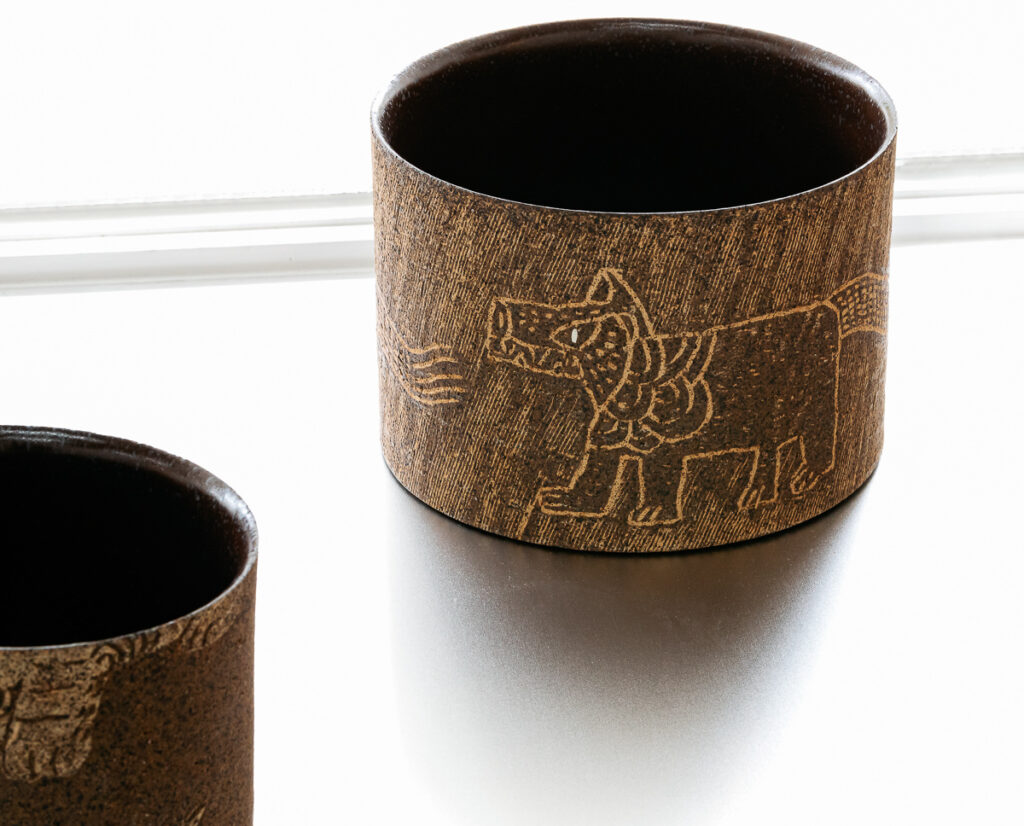
Exhibition view. Yoon Jung x Chae Sangwoo, Imaginary Animal — Lion, 2020. Commissioned by Dochwi for the exhibition Imaginary Animals, Auspicious Companions (2020). ©Dochwidochwi
Imaginary animals also appear in Islamic legends. A buraq, which is described as a mule with the head of a human, ears of a donkey, body of a horse, a peacock’s tail and wings on its sides, alludes to the angelic being that carried the Prophet Muhammad to heaven.3.Buraq, meaning emitting light, is said to symbolize the love of God. Jorge Luis Borges, El libro de los seres imaginarios, trans. Nam Jin-hee (Seoul: Minumsa, 2016), 75–77. On the other hand, half-man, half-animal creatures like the centaurs from Greek mythology or the hippotaynes4.From 1322 to 1356, Mandeville traveled to Turkey, Mesopotamia, Chaldaea, Arabia, the banks of the Nile, Central Asia, India, and Cathay (China) recording local geography, religions, and cultures. In chapter 29, “Of the Countries and Isles that be beyond the Land of Cathay,” of The Travels of Sir John Mandeville is described a man-eating half-man, half-horse creature. John Mandeville, The Travels of Sir John Mandeville (London: Macmillan and Co. Limited, 1900), 177. that Sir John Mandeville saw in Bacharia were violent and vulgar beings. Animals including a pig with a human face (合寙, Ch. heyu), fish with the wings of a bird (䱻魚, Ch. huayu), and owl with human hands that makes the sound of a quail (鴸, Ch. zhu) that appeared in The Classic of Mountains and Seas (山海经, Shanhaijing) were considered ominous signs of disaster such as a flood or drought or other bad occurrences, such as expulsion from a government post.5.The animals that are depicted in the “The Five Treasuries of the Classics of Mountains” (五藏山經, Wucang shanjing), which records the geography and life of a total of twenty-six mountain ranges, are described mainly as unique, that is, as “a composite of several animals,” and “the signs brought by animals are mostly ominous.” Seo Gyeong-ho, A Study of Sanhaijing (Seoul: Seoul National University Press, 1996), 124, 130–132.
Such hybrids of gods and animals, humans and animals, or animals and other animals occupy a significant proportion of the realm of imaginary animals. Having grotesque appearances and possessing numinous powers, these animals, regardless of whether or not they actually exist in the natural world, are all beings that were devised and created in accordance with human perspectives and cultural needs. Therefore, it can be said that human desire is the base of mythical imagination. These desires could be communal ones, such as successful hunting, a year of abundance without drought or flood, prosperity for a family, safety, victory for a race or nation, or the acquisition of a personal benefit such as hearth, success, wealth, longevity, and well-being in the next life. At the moment it is believed that these desires will come true, they are transformed into hope and distributed in the form of myths and legends. In this light, the imaginary animals, half-human/half-animal creatures, legendary creatures, and half-deity/half-animal creatures that appear in ancient myths and legends in both the East and West are transmitters of hope. They nonchalantly traverse time and space and pass hope along to the human realm.
Imaginary Animals on Drawings and Ceramics
Imaginary Animals, Auspicious Companions is composed of works by artists of our time who employ drawing as a major element in their work, reinterpreting the iconography of traditional imaginary animals in their own style. The exhibition unfolds in two streams—one is the iconography of imaginary animals carrying auspicious meaning, and the other is the “ceramic drawings,” that is, methods of expression. Contemporary ceramic patterns have diversified according to personal narratives, environments, interests, and methods of expression, and artists design their own formative language instead of merely executing conventional surface decorations. The artists adjust the texture or color of the clay, and carve, scrape away, and place brushwork on the surfaces. Imaginary Animals, Auspicious Companions seeks to highlight the “drawings on ceramics” created by artists who ably manipulate the relationship between clay, slip, pigments, and glaze and express themselves by implanting narratives and symbols within the layers that comprise the works.
Yon Hokyung, Yoon Jung, Lee Jeongyong, Lee Changhwa, and Huh Sangwook are all ceramicists who have developed their own distinctive styles by selecting materials, techniques, and subject matter through individual artistic and creative will. Chae Sangwoo is a picturebook artist who was invited to participate in the exhibition with the hopes of adding a unique layer to the narrative and portrayal of imaginary animals through his unconventional style of illustration. At the exhibition, the artists present auspicious and guardian beings of which no two are the same and have been created through skilled crafting using classical methods of expression and technique, delicately, but at times boldly, incising, scraping away, and applying color to the surfaces.
Yon Hokyung incises witty drawings and letters on her buncheong vessels covered in white slip. These colored drawings that intuitively express deeply personal thoughts and emotions have established the artist’s distinctive style of buncheong ware together with her satirical vessel forms. In the exhibition, she presents buncheong objet d’art in a folk painting-style featuring animals that embody her personal wishes, such as a pair of cranes, tiger and magpie, and a carp that desires to become a dragon. Her animals, as if performing a self-mocking monologue, spew out the dream of the artist with expressionless faces.
Rather than pursuing pattern-based buncheong ware, the emerging ceramicist Yoon Jung explores ways to express the essence and texture of rough stoneware clay. She presents at the exhibition stoneware vessels that she produced together with the picturebook artist Chae Sangwoo. The collaborative works featuring layers of embedded bold animal drawings by Chae and the incised and scratched away patterns rendered by Yoon are definitely the icing on the cake for the exhibition.
Lee Jeongyong experiments with the expression of white porcelain in our time. In the exhibition, he presents works with gimyeogdo (painting of objects) compositions, arranging vessels with designs of bonghwang and a tiger and cub within a circular frame. Also exhibited are works depicting a flying dragon executed with simple, concentrated brush strokes. Lee adds further layers to the fundamentals of the archetypical white porcelain of the Joseon Dynasty, introducing delicate and elegant cobalt-blue pigments and, moreover, folk humor. In addition, he adds a tactile dimension to his work by applying a rough white slip to the surfaces of his refined porcelain and leaving traces of brushstrokes on the gently hued color planes.
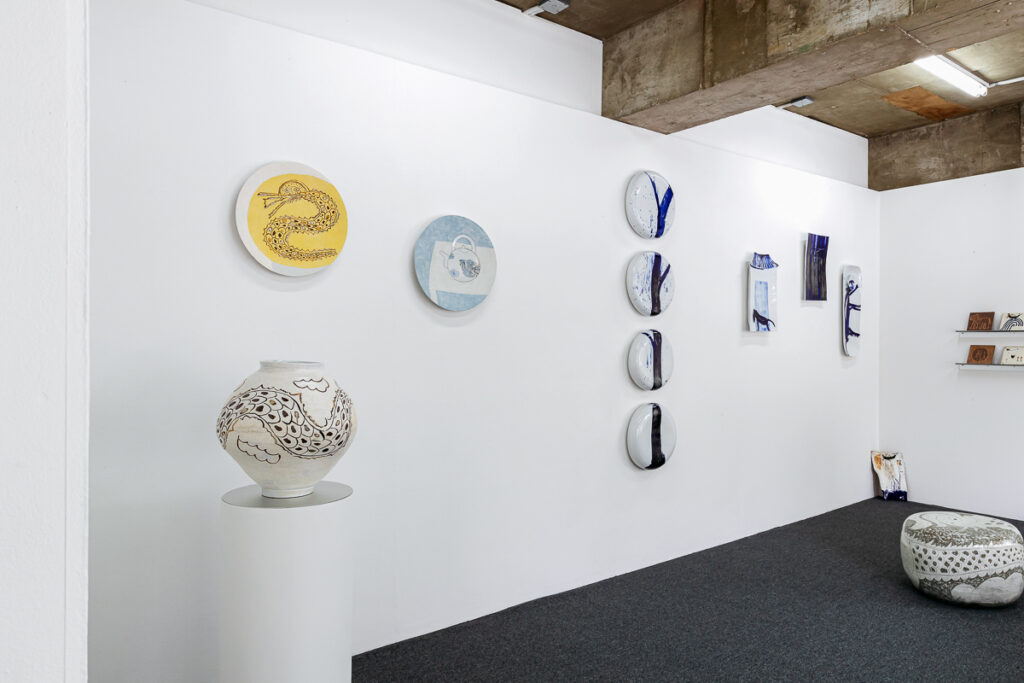
Exhibition view. Lee Jeongyong, White Porcelain Jar and Wall plate with Dragon Design in Underglaze Iron, White Porcelain Wall Plate with Bonghwang Design, 2020. Lee Changhwa, White Porcelain Plates with Animal Design in Underglaze Cobalt-blue, 2020. Commissioned by Dochwi for the exhibition Imaginary Animals, Auspicious Companions (2020). ©Dochwidochwi
Lee Changhwa has developed a unique style of white porcelain through a process of constant renewal. Following his usual method of work, voluntarily detaching himself from the outside world, he has created completely imaginary creatures that are indecipherable from the perspective of preexisting iconography. These mythological creatures drawn spontaneously from energies poured out in moments of immersion slowly reveal a mythical and dignified energy from the layer of deep, intense cobalt-blue underglaze.
Huh Sangwook conveys the vitality inherent in buncheong through his remarkable sensitivity in working forms and planes. His distinctive vivacious animal drawings have become more free-spirited by incorporating traditional imaginary animals as iconography. He has filled the surfaces of his vases, stools, and cups characterized by round, warm, relaxed silhouettes with drawings of dragons, white tigers, girin, haetae, moon rabbits, and inmyeonjo. His animals, each embracing a unique narrative, comfort us with a gentle smile on their faces.
Layers is another conceptual framework that underlies Imaginary Animals, Auspicious Companions. Layering, or overlapping, is a material and ontological characteristic of the ceramic medium since ceramics is a component of human activity not only for its layers of materials, techniques, decorative patterns, and production processes, but also from the perspective of the developmental history of the techniques and styles and cultural hybridity of content and form. This is also a feature of murals rendered on natural earth surfaces. Similar to ceramics, murals are artistic expressions with the practical purpose of visualizing narratives with embodiments of wishes using mineral pigments on earthen supports as well as works that are completed through the layering of various materials and processes.6.Though varying by region and period, ancient murals, in general, have a support (rock structure or brick obtained from nature) overlaid with at least one coat of base layer (mortar paste made with clay and sand and an adhesive mixture made of plaster and vegetable substances) to make the surface even and then finished with a white plaster mixture combining limestone, sand, and feldspar minerals. It is to this top layer that pigment was painted. In order to prevent the alkalinity of limestone from deteriorating the pigments of the panting, an acidic mixture or impermeable lime-organic composite was coated several times before adding the coloring layer.
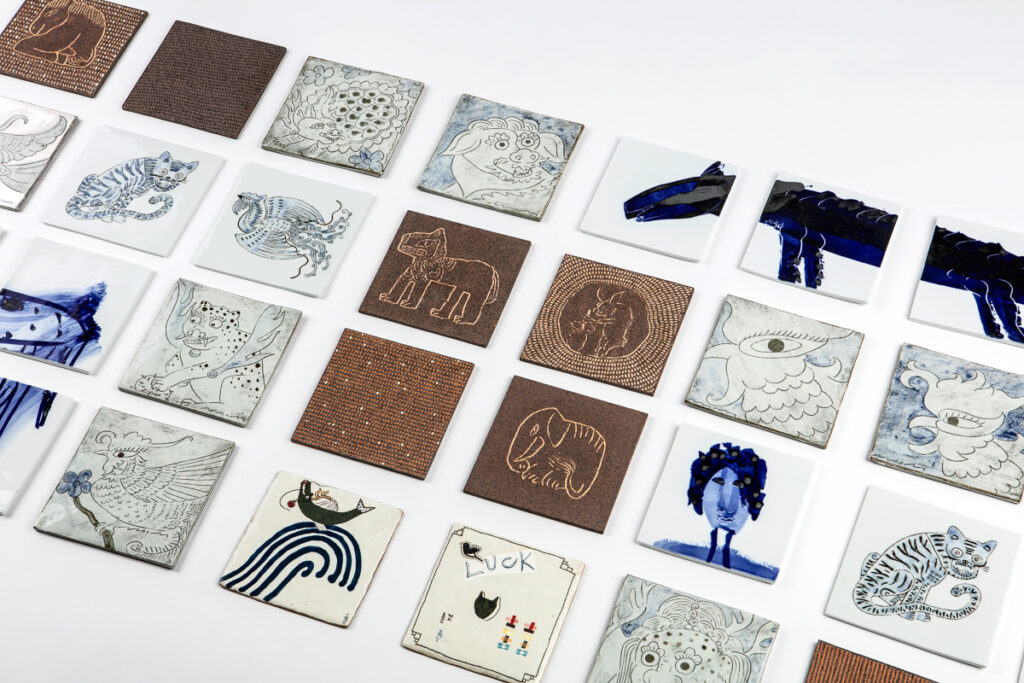
Special Edition Tiles Auspicious Animals, commissioned by Dochwi for the exhibition Imaginary Animals, Auspicious Companions (2020). ©Dochwidochwi
In this light, the spatial dimension of the exhibition has also appropriated the similarity between ceramics and murals and the concept of layering. Under the basic direction of presenting murals in a three-dimensional space, we tried to create layers of diverse materials and perspectives. First, all the works have been arranged horizontally and vertically so that they can be enjoyed from both inside and outside the exhibition space. Moreover, the display stands are comprised of stacked blocks made of mortar and plaster and finished with metal tops to serve as a metaphor for the material layers of murals. The ceramics with drawings are placed on these stands. In other words, murals are inserted into ceramics, and the ceramics becomes a decorative pattern that emerges on top of the three-dimensional mural.
Imaginary Animals, Auspicious Companions presents ceramics that anyone can enjoy. In 2020, all of us living in the no-contact era require consolation. It is hoped that the exhibition will offer a gentle smile and comfort to our dry and difficult lives through animal friends, and moreover an opportunity for artists and appreciators to revel, both together and individually. It is hoped that everyone will someday come to encounter ceramics that speak to them and enjoy elegant and beautiful moments in his/her own space, whether it be a tiny studio or a spacious house with a yard—to imagine and discover small yet illuminating existences that fill the time and space that we must endure alone.
✿
A Skeptical Poet: Yon Hokyung
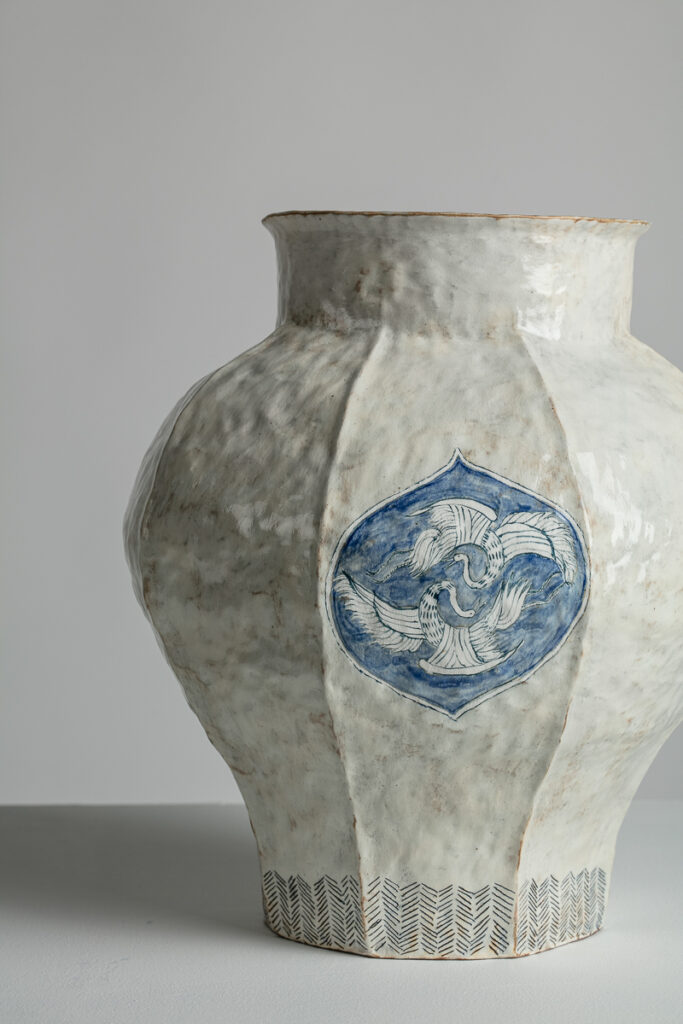
Yon Hokyung, Buncheong Jar with Double Crane Design, 2020. Commissioned by Dochwi for the exhibition Imaginary Animals, Auspicious Companions (2020). ©Dochwidochwi
Long ropes of clay are layered one on top of another and pinched bit by bit to form a vessel. This meticulous refinement of the shape is a slow process that allows a time for thinking what kind of design to draw and what kind of form would be suitable for the pattern. Even while the hands are in motion shaping the thoughts and form, deep concentration is exercised. It is amidst this concentration that the distinctive attribute of Yon Hokyung’s work emerges: a sophisticated sarcastic humor.
The works of Yon Hokyung are somewhat comical. From a flattened bottle with overly thick sides to a stout jar with only slight traces of a rim or a maebyeong (plum bottle) that is almost cylindrical with the conventional elegant curves barely apparent, Yon exaggerates or omits the main elements of the typical forms of familiar ceramics, creating forms that are a bit odd and eccentric, but still friendly and comforting. This is another reason why Yon builds her forms using the pinching technique.7.One of the oldest methods of shaping clay, pinching involves using the thumb and index finger to pinch the clay to build up a form. It makes it possible to create forms that are more free-spirited, and the finger marks on the walls offer a tactile quality.
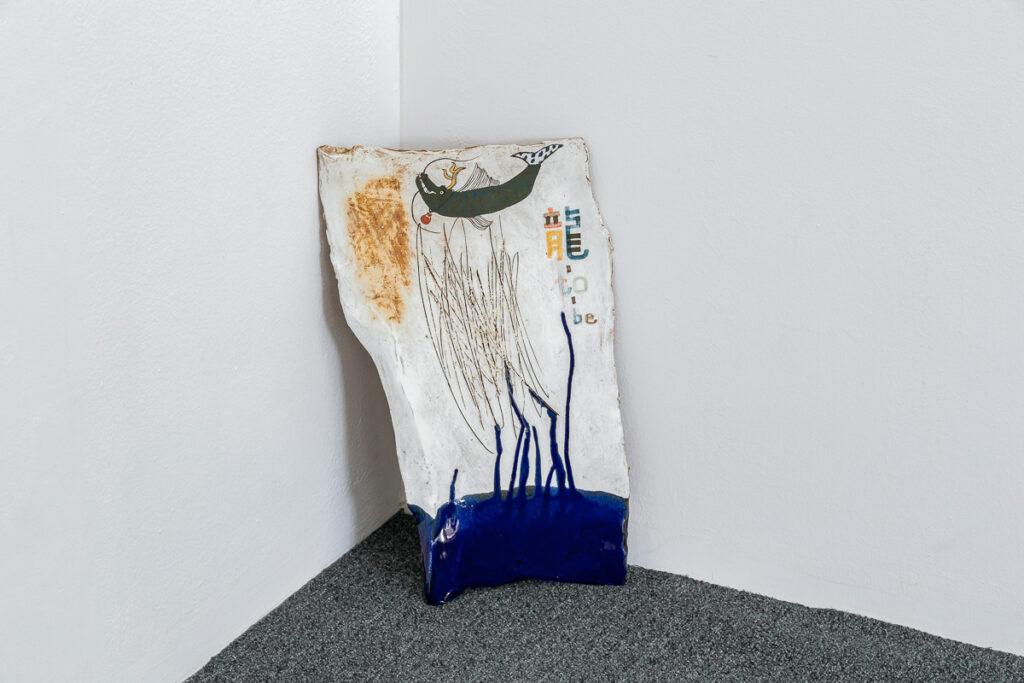
Exhibition view. “Yong (dragon)-to-be” Roof tile-shaped Object, 2020. Commissioned by Dochwi for the exhibition Imaginary Animals, Auspicious Companions (2020). ©Dochwidochwi
She finds “…fun in gradually transforming the angle and size while building up” from the base,8.Yon Hokyung (artist) in conversation with the author, August 2020. and this technique also allows her to pursue expressions that are more liberal and humanistic. In the case of Buncheong Jar with Double Crane Design 9.Designs featuring a pair of cranes is an auspicious motif that was often used on pillow-ends and rank badges of government officials in the Joseon Dynasty (1392–1910). The crane, a mystical creature believed to live for two thousand years, is one of the ten symbols of longevity and served as conveyance of the immortals. It has been widely depicted in the arts, including on paintings, ceramics, and embroidery, often in combination with pine trees and waves as a symbol of high official rank or success. Yoon Yeol-su, Imaginary Animals in Mythology (Seoul: Korea Cultural Heritage Foundation, 2017), 76–81. (2020), the walls were built up from an octagonal base and edges created through pinching. The edged planes and curved planes are subtly merged through the traces of the fingers. Thin curvature emerges above the milky-white slip. The gentle sinuations of the surface directly reveal the traces of the movements of the artist’s fingers.
Yon’s satirical method of expression is most evident in the drawings engraved like scribbles on the white slip applied all over the brown buncheong clay body. Rather than following the traditional characteristic style of buncheong, which reveals the clay under the slip through a range of techniques, Yon covers the base clay with white slip. Though her works are essentially buncheong ware, she treats them like white porcelain, relishing their white ground.10.Buncheong is a style of Korean ceramics that emerged in the late fourteenth century in which white slip is applied over a brown clay used for producing celadon ware to create white surfaces and resemble white porcelain. Through variations in decorative techniques, including scraping away, incision, and drawing on the white slip-covered surfaces, buncheong eventually achieved a more diverse and dynamic development in the fifteenth and sixteenth centuries than did white porcelain. On top of the white slip surface are drawn clusters of lines seemingly rendered haphazardly in a ballpoint pen, forming common everyday objects such as fruit, plant leaves, and glasses executed in a watercolor-style, along with self-ridiculing, sardonic remarks like “I Have No Idea” and “Beware of Dog.”
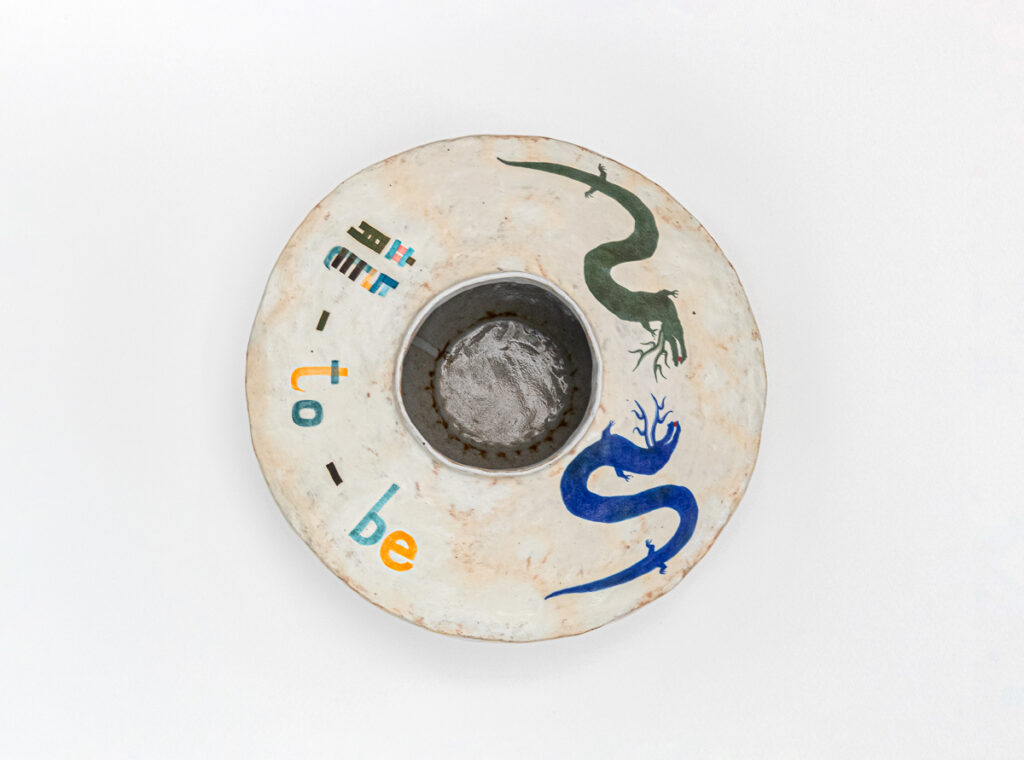
Yon Hokyung, “Yong (dragon)-to-be” Vase (top), 2020. Commissioned by Dochwi for the exhibition Imaginary Animals, Auspicious Companions (2020). ©Dochwidochwi
Yon, who casually depicts her offbeat, everyday thoughts in this way, also has a talent for illustrating animals using simple yet spirited lines. From an eagle standing pompously with its head peeping out from a voluminous coat of feathers to a crane taking shelter from the rain under a leaf or a person trying to do a handstand, the artist observes her subject matter in accordance with the expressive method of folk paintings, grasps its unique characteristics, and depicts it as simply as possible while imagining the subject in diverse but somewhat eccentric circumstances. She seems to take a dry and detached approach to her subjects rather than empathizing or engaging with them. As a result, the drawings of Yon Hokyung invite viewers to imagine and create their own narratives. Instead of telling a story through her work, Yon encourages “creative writing” from the viewers.
Yong (dragon)-to-be (2020) is a work in a form resembling a roof tile depicting the iconography of a carp in transforming into a dragon (登龍門, K. deungyongmun)11.The Chinese word “登龍門,” literally meaning “ascending the Dragon Gate,” originates from the legend that a carp that can swim upstream and then leap the waterfall named Dragon’s Gate cascading in the upper reaches of the Yellow River in late spring will be transformed into a dragon. It has been used as a metaphor for a gateway to success, that is, a person’s success in overcoming difficult challenges, mainly the state examinations. The motif has been often visualized as a leaping carp. The carp that failed to leap the gate are said to have returned to the water with black spots on their heads resulting from hitting the rough rock walls. in the folk painting style. It captures the moment of a carp leaping out of the water to become a dragon. The creature depicted still has the body of a carp, but it is carrying a cintamani (a wish-fulfilling jewel) in its mouth and turning into a dragon starting at its head. The carp is characterized by an integration of features from fish-shaped Buddhist percussion instruments (木魚, K. mogeo) and the haetae (lion-like horned mythical creature believed to be a guardian against fire and disasters) of munbaedo folk paintings. Below this “dragon-to-be,” streams of water from the Dragon’s Gate shoot powerfully upwards. These streams executed in cobalt-blue underglaze, seem to reveal the strong desire of the carp to become a dragon. The eyes staring directly at the viewer together with the gently upturned corners of the mouth seem to convey a sense of hope. It is unknown whether this “dragon-to-be” actually succeeds at becoming a dragon. Perhaps it is because its fins still seem awfully small to fly through the sky. He may be just an ordinary carp freed in a pond where a dragon once lived.12.Jeong Jong-wu, Animals of the Joseon Dynasty (Seoul: Seohaemunjip, 2014), 254.
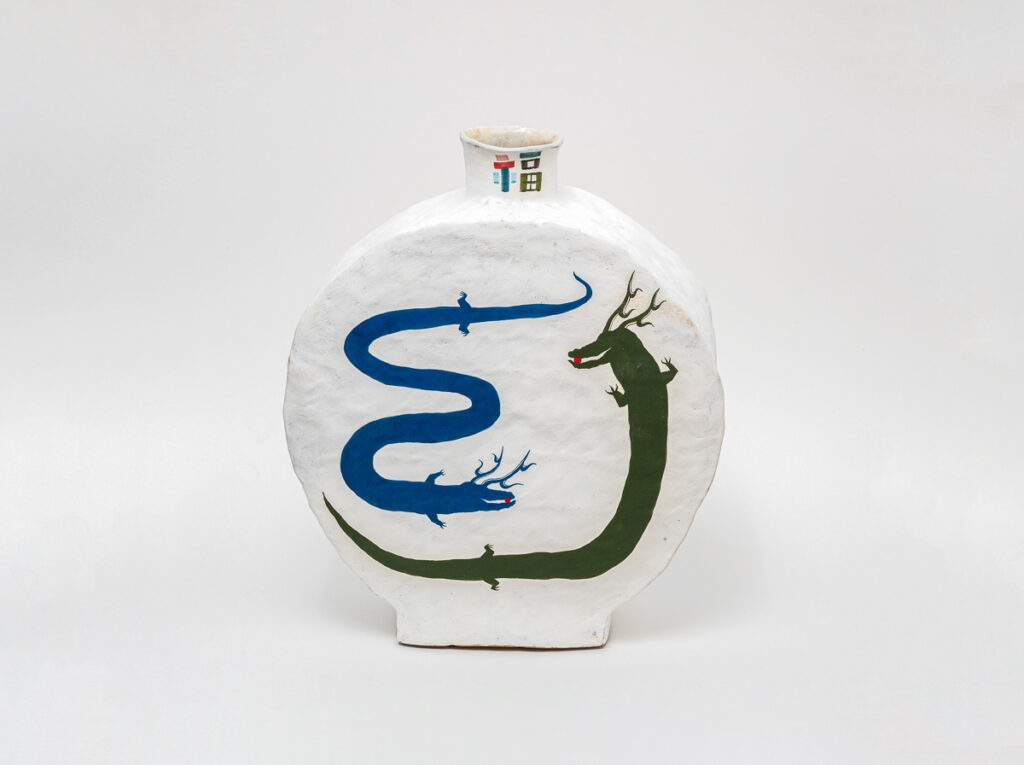
Yon Hokyung, “Yong (dragon)-to-be” Flask Vase, 2020. Commissioned by Dochwi for the exhibition Imaginary Animals, Auspicious Companions (2020). ©Dochwidochwi
Another Yong (dragon)-to-be (2020) is a flat jar featuring on its shoulder two salamanders gazing around, each grasping a cintamani in its mouth. The work Luck喜 (lucky) (2020) features a playful depiction of a “tiger and magpie.”13.The Painting of Tiger and Magpie (虎鵲圖, K. hojakdo), which is an iconography of Ming China (1368–1644), became widely popular in nineteenth-century Joseon as a symbol of “good news.” However, Cheongpa geukdam (靑坡劇談, Treatises of Cheongpa) written by Yi Ryuk (1438–1498), a writer of early Joseon, contains records of a folktale detailing, “if a magpie builds a nest on the southern side of the house, then the owner will be appointed to a government post,” suggesting that magpies have long been an auspicious symbol in Korea. Ibid., 195–198. Contradicting the theme of the work, luck and double happiness (囍), the magpie seems to be flying away with its news of good fortune while the tiger appears shadowed with anxiety.
In this way, the animal drawings of Yon Hokyung, which seem a bit clumsy but not absurd while they embody a strong character yet retain a sense friendliness, are a representation of her artistic world. Her artistic speech—deviating from the classic beauty of perfection but creating a playful and warm emotional embrace—is further concretized through the interaction of form and decorative designs and her in-depth understanding and continued experimentation with diverse expressions of color and texture. Also at the core of her work is an emotional distance. She expresses life as if giving it a “pinch,” and the delightful ceramics that result become objects with which viewers can recall their own memories and generate new inspiration and imagination.
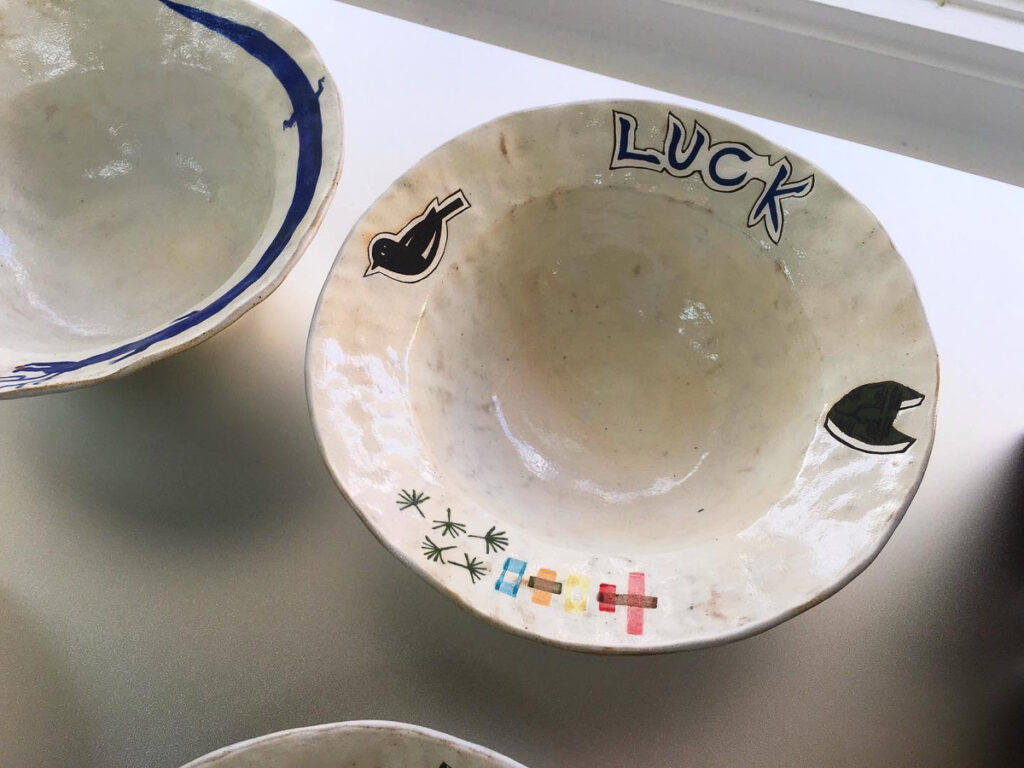
Exhibition view. Yon Hokyung, “Luck喜 (lucky)” Bowl, 2020. Commissioned by Dochwi for the exhibition Imaginary Animals, Auspicious Companions (2020). ©Dochwidochwi
This article is written in Korean by Moon Yujin and translated into English by Ahn Soyean.
About Moon Yujin
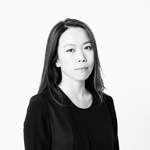 Moon Yujin is an independent curator and writer based in Seoul, Korea. She has curated numerous international projects including exhibitions, performances and conferences, aiming to incorporate the aesthetic experience into ordinary life and examining inter-exchanges of art practices in diverse genres embracing arts, crafts, music and food. Her current research interest lies in the “hybridity” in artistic practices that interact with changes of societal conditions as well as in pursuing a proper method of knowledge-producing curation. She has worked as curator at several public institutions including Asia Culture Center in Gwangju and Korea Ceramic Foundation in Icheon, and also initiated various project-based collectives with colleague-curators and artists.
Moon Yujin is an independent curator and writer based in Seoul, Korea. She has curated numerous international projects including exhibitions, performances and conferences, aiming to incorporate the aesthetic experience into ordinary life and examining inter-exchanges of art practices in diverse genres embracing arts, crafts, music and food. Her current research interest lies in the “hybridity” in artistic practices that interact with changes of societal conditions as well as in pursuing a proper method of knowledge-producing curation. She has worked as curator at several public institutions including Asia Culture Center in Gwangju and Korea Ceramic Foundation in Icheon, and also initiated various project-based collectives with colleague-curators and artists.
Related stories
Entangled threads: Woven knowledge systems
Castlemaine Currency: Towards a grounded economy
Sindhu - The river line: A dialogue
Flamboyance and intensity: Contemporary ceramics of Peter Cooley
Kevin Millward: The pleasure of anonymous artifice
Late Muhammad Nawaz: The unsurpassable master potter from Harappa, Pakistan
A healing walk: The Lake Bolac Eel Festival story
The Protest Banner Lending Library: Democracy in the making
References
| ↑1 | Watanabe Chikako, “The Lion Metaphor in the Mesopotamian Royal Context,” Topoi, Orient-Occident Supplément 2: Les animaux et les hommes dans le monde syro-mésopotamien aux époques historiques (Lyon: Persée, 2000), 399–409. |
|---|---|
| ↑2 | The lion symbolizes the goddess Ishtar defending the dynasty and the army, while the bull and mušuššu represent the chief gods of Babylonia: Adad, who controls the rain, and Marduk, the god of light, sun, and virtue. Mušuššu, meaning “red snake” in Sumerian, is an imaginary animal with claws like a lion, hind legs like those of a bird, and the tail, neck, head, and tongue of a snake. |
| ↑3 | Buraq, meaning emitting light, is said to symbolize the love of God. Jorge Luis Borges, El libro de los seres imaginarios, trans. Nam Jin-hee (Seoul: Minumsa, 2016), 75–77. |
| ↑4 | From 1322 to 1356, Mandeville traveled to Turkey, Mesopotamia, Chaldaea, Arabia, the banks of the Nile, Central Asia, India, and Cathay (China) recording local geography, religions, and cultures. In chapter 29, “Of the Countries and Isles that be beyond the Land of Cathay,” of The Travels of Sir John Mandeville is described a man-eating half-man, half-horse creature. John Mandeville, The Travels of Sir John Mandeville (London: Macmillan and Co. Limited, 1900), 177. |
| ↑5 | The animals that are depicted in the “The Five Treasuries of the Classics of Mountains” (五藏山經, Wucang shanjing), which records the geography and life of a total of twenty-six mountain ranges, are described mainly as unique, that is, as “a composite of several animals,” and “the signs brought by animals are mostly ominous.” Seo Gyeong-ho, A Study of Sanhaijing (Seoul: Seoul National University Press, 1996), 124, 130–132. |
| ↑6 | Though varying by region and period, ancient murals, in general, have a support (rock structure or brick obtained from nature) overlaid with at least one coat of base layer (mortar paste made with clay and sand and an adhesive mixture made of plaster and vegetable substances) to make the surface even and then finished with a white plaster mixture combining limestone, sand, and feldspar minerals. It is to this top layer that pigment was painted. In order to prevent the alkalinity of limestone from deteriorating the pigments of the panting, an acidic mixture or impermeable lime-organic composite was coated several times before adding the coloring layer. |
| ↑7 | One of the oldest methods of shaping clay, pinching involves using the thumb and index finger to pinch the clay to build up a form. It makes it possible to create forms that are more free-spirited, and the finger marks on the walls offer a tactile quality. |
| ↑8 | Yon Hokyung (artist) in conversation with the author, August 2020. |
| ↑9 | Designs featuring a pair of cranes is an auspicious motif that was often used on pillow-ends and rank badges of government officials in the Joseon Dynasty (1392–1910). The crane, a mystical creature believed to live for two thousand years, is one of the ten symbols of longevity and served as conveyance of the immortals. It has been widely depicted in the arts, including on paintings, ceramics, and embroidery, often in combination with pine trees and waves as a symbol of high official rank or success. Yoon Yeol-su, Imaginary Animals in Mythology (Seoul: Korea Cultural Heritage Foundation, 2017), 76–81. |
| ↑10 | Buncheong is a style of Korean ceramics that emerged in the late fourteenth century in which white slip is applied over a brown clay used for producing celadon ware to create white surfaces and resemble white porcelain. Through variations in decorative techniques, including scraping away, incision, and drawing on the white slip-covered surfaces, buncheong eventually achieved a more diverse and dynamic development in the fifteenth and sixteenth centuries than did white porcelain. |
| ↑11 | The Chinese word “登龍門,” literally meaning “ascending the Dragon Gate,” originates from the legend that a carp that can swim upstream and then leap the waterfall named Dragon’s Gate cascading in the upper reaches of the Yellow River in late spring will be transformed into a dragon. It has been used as a metaphor for a gateway to success, that is, a person’s success in overcoming difficult challenges, mainly the state examinations. The motif has been often visualized as a leaping carp. The carp that failed to leap the gate are said to have returned to the water with black spots on their heads resulting from hitting the rough rock walls. |
| ↑12 | Jeong Jong-wu, Animals of the Joseon Dynasty (Seoul: Seohaemunjip, 2014), 254. |
| ↑13 | The Painting of Tiger and Magpie (虎鵲圖, K. hojakdo), which is an iconography of Ming China (1368–1644), became widely popular in nineteenth-century Joseon as a symbol of “good news.” However, Cheongpa geukdam (靑坡劇談, Treatises of Cheongpa) written by Yi Ryuk (1438–1498), a writer of early Joseon, contains records of a folktale detailing, “if a magpie builds a nest on the southern side of the house, then the owner will be appointed to a government post,” suggesting that magpies have long been an auspicious symbol in Korea. Ibid., 195–198. |

